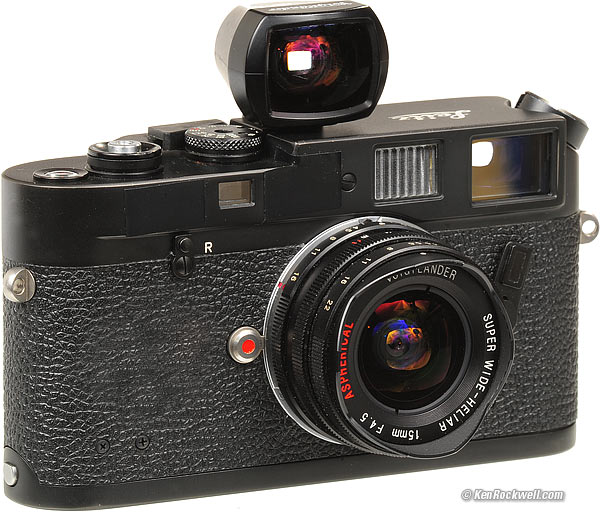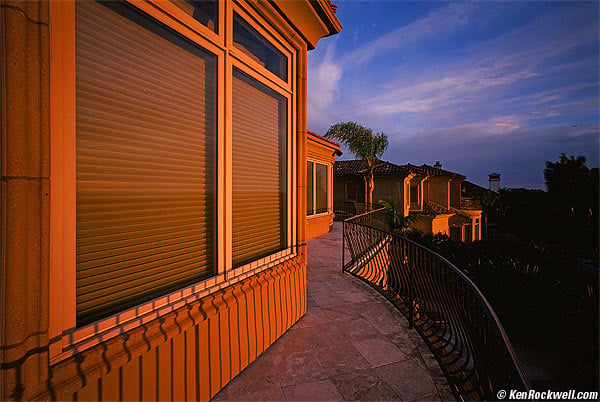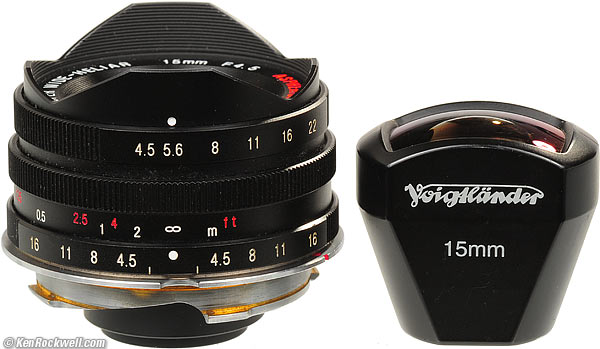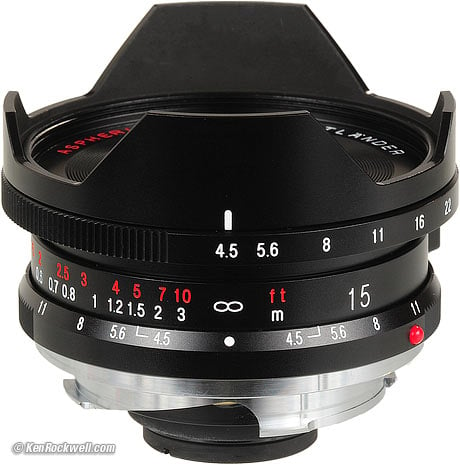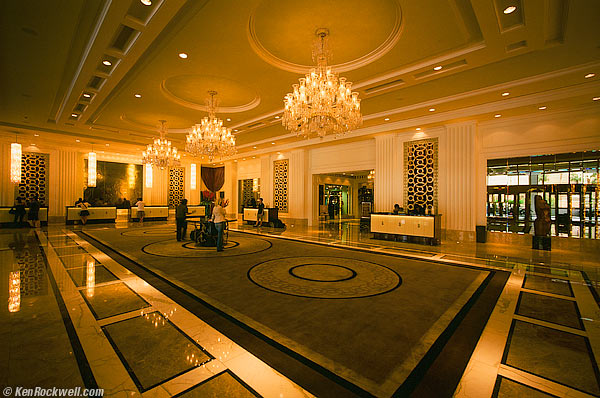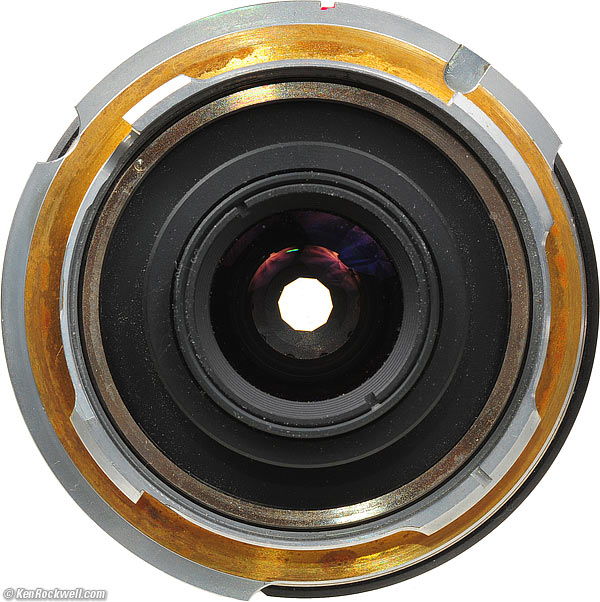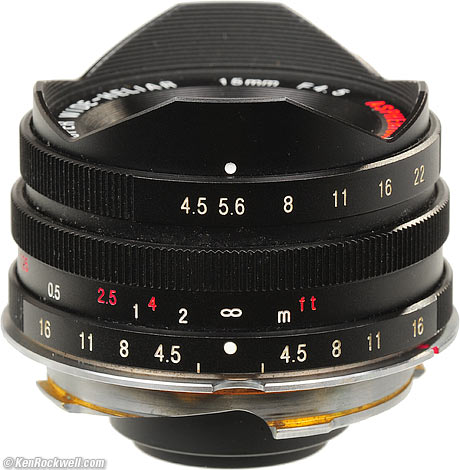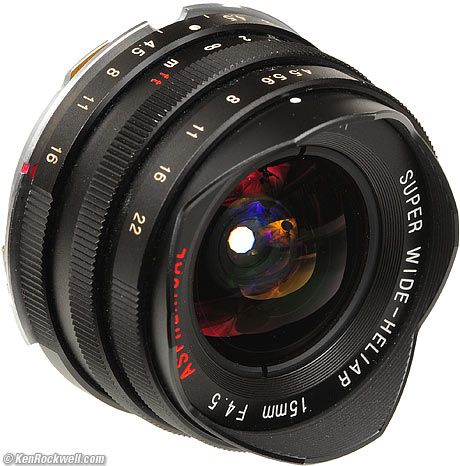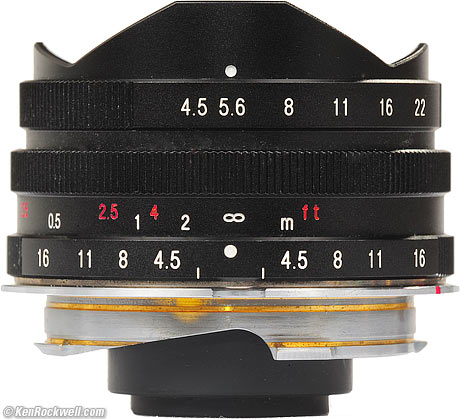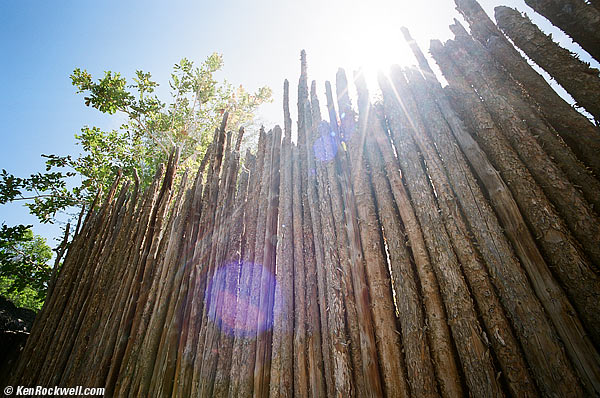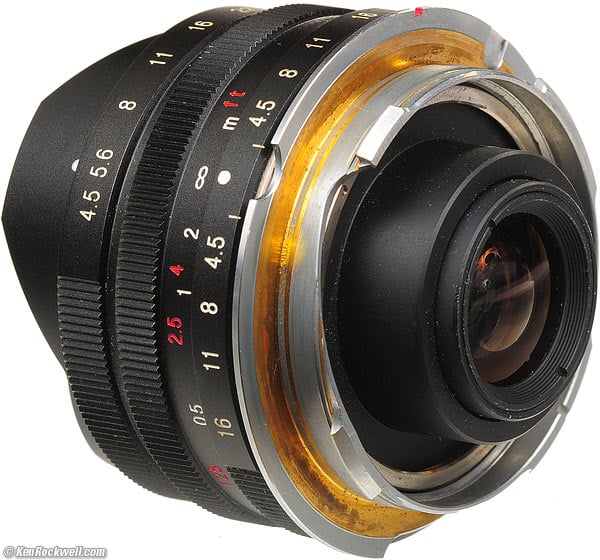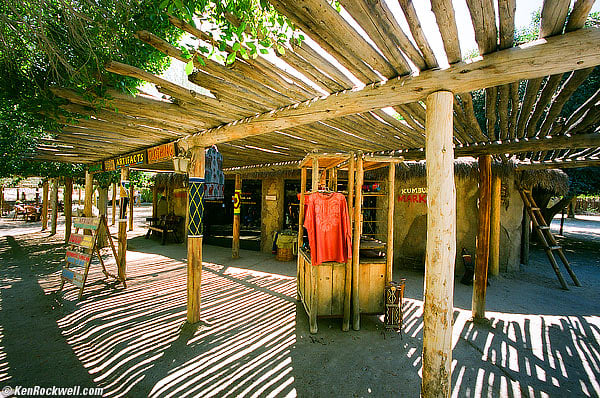Home New Search Gallery How-To Books Links Workshops About Contact
Voigtländer 15mm f/4.5
Cosina Super-Wide Heliar (1999-2009)
Discontinued; replaced by new 15mm M.
© 2009 KenRockwell.com. All rights reserved.
Intro Specs Performance Usage Recommendations
Voigtländer (Cosina) 15mm f/4.5 ASPH with finder on a Leica M4-P, roughly actual size (no filters, 4.090 oz/116.0g). enlarge. It comes in silver, too. You can get them at Adorama, Amazon and B&H. (I got this old one off this link to it at eBay.) Don't forget the adapter required to mount it on the camera. It helps me keep adding to this site when you use these links to get your goodies. Thanks! Ken.
WARNING: Although wonderful on film, this lens is awful on the LEICA M9 because its rear nodal point is too close to the sensor.
The left and right sides take on weird color shifts.
For the M9, get the LEICA 16-18-21mm zoom instead. If you can afford an M9, you can afford the lenses it deserves.
This Voigtländer lens is optimized for film, not for digital.
May 2009 More Leica Reviews New Voigtlander 15mm M Review
More Voigtländer Reviews Nikon Canon LEICA Pentax
Gran Tortuga Resort, Cayman Island.
Voigtländer 15mm, f/8 at 1/15, hand-held Leica M7, RVP50, NCPS scan. enlarge.
The total lack of distortion of this 15mm lens is astounding. For those of you who think you can just see a little pincushion distortion on the left edge of the stone trim, I double checked the hotel: the stones really are slightly crooked! This image renders them correctly; it also renders the straight left vertical edge of the window frame straight.
| Optics: | |
| Mechanics: | |
| Ergonomics: | |
| Usefulness: | |
| Availability: | |
| Overall: |
Ideal Uses: Perfect for use on any Leica or similar camera.
Not for: It's difficult to impossible attach filters to this lens.
Introduction top
Intro Specs Performance Usage Recommendations
|
I personally buy from Adorama, Amazon, Ritz, B&H, Calumet and J&R. I can't vouch for ads below.
|
This Voigtländer 15mm f/4.5 ASPH is tiny, inexpensive and outperforms Leica's ultrawide lenses. It's that good.
It was replaced in spring 2009 by the Voigtlander 15mm f/4.5 M II, which has the the same optics in a superior mount.
Voigtländer is an old, dead brand name owned by Zeiss and licensed to Cosina of Japan. Cosina makes this lens, and Cosina also makes most of the Zeiss lenses used in 35mm and digital still photography.
This 15mm lens is at least as sharp as the Leica 21mm f/2.8 ASPH, has far less distortion than the Leica 21mm, and is only one-tenth the price.
This Voigtländer 15mm isn't merely "good enough" or "almost as good" or "decent for the price" compared to Leica. This Voigtländer 15mm lens is superior to the Leica ultrawide lenses because it's sharper and has less distortion than the Leica 21mm f/2.8 ASPH. I have not tried the Leica 18mm or Leica 16-21mm zoom, however those lenses are rated by Leica as even worse than the Leica 21mm for distortion.
The Leica 21mm f/2.8 ASPH costs $4,300, without finder. This lens costs just $480 with included finder and additional mandatory adapter. If you're shooting screw-mount, the lens and finder without the screw-to-M adapter is $420.
And in case I forget, this 15mm lens is also wider than anything modern from Leica. Even if you blow 20 grand on a collectible Hologon 15mm f/8, this 15mm lens is still almost two stops faster, has a diaphragm for better depth of field control and has much less falloff.
How does Cosina do it? I bet Leica would love to know, but I have no idea. One way Voigtländer does it is to keep the aperture reasonable (f/4.5) instead of pushing things by trying to make it f/2.8.
Not only is it optically superior and one-tenth the price of the Leica 21mm, Leica 18mm or Leica 16-21mm zoom, this tiny lens is only a fraction of the size and only one-third the weight.
It's so small that most of the images in this review have been blown up two or three times so they fit on the page. On most computers with 106 DPI LCD monitors, click the Life Size links to see it actual size.
The only downside to this 15mm lens is that there is no easy way to use filters, which are critical for serious photography, but less so if you're just plinking away with digital.
A huge upside is that the Voigtländer 15mm is so tiny that there is no viewfinder blockage, another huge advantage over Leica's own overgrown ultrawide lenses.
I shoot full-frame, not the pathetic little half-frame sensor of the M8.2 which largely eliminates the whole point of a 15mm lens. If you shoot the M8, this becomes about a 20mm lens. On the M8, have a look at the Cosina Voigtländer 12mm lens, which becomes about a 16mm lens on the M8.2. On the M8.2, you'd use the Voigtländer 15mm finder when using the 12mm lens.
All my comments, unless otherwise stated, refer to shooting this 15mm lens on a full-frame Leica M camera, using a Leica screw to Leica-M mount adapter. I get full-frame digital by checking the box to have all my images digitized when my film is run at my lab.
This lens works just as well on ancient Leica screw-mount cameras, for which you save yourself $60 and a half-ounce (15g) by not having to buy the adapter. Once you screw-on the adapter as I have, you forget about it and this is just another M-lens in your pocket.
Not only is this Voigtländer lens better optically than Leica's own ultrawide offerings, this Cosina 15mm lens is more in the spirit that drives the true Leica photographer. The essence of Leica photography is excellence in small, portable packages, at which this lens excels. Leica's current ultrawide lenses have long lost sight of the Leica dream, and like many Americans, have become too big and too fat. This 15mm f/4.5 has all the optical quality demanded by the Leica man, in the tiny size that defines classic Leica photography.
Voigtländer 15mm and finder, twice life-size. enlarge more.
New Version: 2009 top
New Voigtländer 15mm f/4.5 for Leica M, twice actual size. enlarge.
As of 2009, Voigtländer announced a new version which uses the same extraordinary optics and adds rangefinder coupling and a 52mm filter thread. I'd get it over the earlier lens reviewed here.
Mario's Italian Café, Palm Desert, California. enlarge.
Voigtländer 15mm, f/4.5, 1/8 second, hand-held, Fuji Reala 100 shot in a Minolta CLE, NCPS processing.
Specifications with commentary top
Intro Specs Performance Usage Recommendations
Name
Cosina calls this the Voigtländer SUPER WIDE-HELIAR 15mm f4.5 ASPHERICAL.
If Leica sold this, which they don't, they would call this the LEICA SUPER-HEKTOR-M 1:4.5/15 ASPH.
Focal Length top
15mm.
35mm equivalent: 15mm. Duh, this is a full-frame 35mm lens.
Digital Equivalent: 15mm. Duh, I have all my film scanned direct to digital.
Digital Resolution: 25MP when shot on film.
Equivalent if wasted on the Leica M8 (half-frame): 20mm.
Equivalent on the Epson R-D1 (half-frame): 23mm.
Angle of View (full-frame 35mm) top
Lobby, Trump Tower, Las Vegas. Leica M7 economical frame 39 of a roll of Fuji Velvia 50, f/4.5 at 1/6 second, hand-held. enlarge.
110º Diagonal.
100º Horizontal.
77º Vertical.
(less on lesser formats.)
Optics top
8 elements in 6 groups.
One aspherical element.
Multicoated.
Diaphragm top
Voightlander 15mm f/4.5, triple life-size. enlarge more.
10 straight blades. (Leica only uses 8, ha ha.)
Stops down to f/22 (Leica only goes to f/16, ha ha ha ha ha ha.)
Half-stop clicks, exactly like Leica, and in the same direction with the same spacing, too.
Filter Thread top
NONE.
We'll discuss this later.
Close Focus top
1 foot (0.3 meters).
Caps top
Uses standard Leica 14 269 rear caps.
Dedicated metal front slip-on cap, felt-lined.
Hood top
Voigtländer 15mm f/4.5, twice life-size. enlarge more.
Little petals permanently built-in.
Size (as measured by me) top
Maximum Diameter: 2.007" (50.97mm). (widest part: the M adapter, not the lens itself)
Maximum Diameter without M Adapter: 1.939" (49.25mm). (49.6mm, specified)
Outer Diameter of Forebarrel: 1.711" (43.45mm). (for slip-on accessories).
Extension from Flange: 1.248" (31.70mm), measured at infinity. (30.7mm specified, without M adapter.)
Weight (as measured by me) top
4.090 oz. (116.0g) with M adapter, but no caps.
4.710 oz. (133.5g) with caps and M adapter.
3.645 oz. (103.35g), naked lens cell only (screw mount).
3.71 oz. (105g), specified.
Finder (included) top
Type: Image appears as a rectangle inside black. No lines.
Magnification: 0.38x.
Optics: 4 elements in 4 groups.
Diopter: -1.0.
Weight: 1.115 oz. (31.65g), measured. (specified: 33g.)
Product Numbers top
Black Lens and Black Finder: BA212B
Silver Lens and Black Finder: BA212A
Black Finder only: DA407A
Introduced top
Some time around 2000.
Voightlander 15/4.5, twice life-size. enlarge more.
Performance top
Intro Specs Performance Usage Recommendations
Overall
This is a tiny, easy to use lens which gives extraordinary results.
It is ridiculously sharp, even at f/4.5 in the corners, and completely devoid of any visible distortion.
This little thing has about the same sharpness as a macro lens, and much less distortion than most lenses of any kind, much less ultra wide angles.
Aperture Ring top
The aperture ring is as good as anything from Leica, except that it has only Cosina's weak, thin triangular knurling instead of Leica's deeper rectangular siping.
Bokeh top
There is never anything out of focus, so bokeh has no meaning here.
Coma top
There is no coma.
Bright points of light on the sides simply look like bright points of light.
This is wonderful, because most ultrawide lenses turn these points of light into blobs or batwings in the corners.
This 15mm lens has no coma, even at f/4.5. Yay!
Depth-of-Field top
Depth-of-field is nearly unlimited, even wide open.
This is normal for ultra-wide lenses.
Your biggest concern is to be careful not to knock the focus to 1 foot (0.3m) and shoot there all day by accident.
Diaphragm Linearity top
My M7 agreed exactly as I tried every half-stop.
Lesser lenses often become inaccurate at smaller apertures.
This isn't important on cameras which meter through-the-lens at taking aperture, like most modern Leicas, but it could lead to inaccurate exposures if you're using an external meter.
As far as I can measure, this Cosina lens is perfect. The Leica 21mm f/2.8 ASPH is almost as good.
Distortion top
Surprise: Any distortion is absolutely invisible!
The Voigtländer 15mm has even less distortion than Nikon's 60mm f/2.8 Macro lens! This is unheard of for an ultrawide angle lens, and even Nikon's normal lenses have more distortion than this ultrawide.
I'm simply astounded, It's far better than the minor distortion of the Leica 21mm f/2.8 ASPH.
For critical use, you can use your shots as-is, or use a value of -0.25 in Photoshop's Lens Distortion Filter when shot at 4 feet (1.5m).
Not only is the distortion invisible, if you are measuring it, it is easily correctable in Photoshop's Lens Distortion Filter. It has none of the higher-order complexity of other lens' distortion signatures which make them harder to correct in Photoshop.
Ergonomics top
Cosina 15 4.5, twice life-size. enlarge more.
Ergonomics?
All this tiny lens has is an aperture ring and a focus ring. There's no room for anything else.
Both work well, without problems.
This lens is a joy to use.
Falloff (darkened corners) top
Falloff is healthy, as expected.
It's visible, which is what you want to emphasize the huge angle seen by this lens.
Falloff doesn't change much at smaller apertures.
Falloff is a little more abrupt than other lenses as you approach the corners, but otherwise, this lens performs exactly as I'd expect for a 15mm rangefinder lens.
It has much less falloff than the Zeiss 16mm f/8 Hologon for the Contax G, but it still has plenty of falloff. Use it to your advantage.
It's less than the 12mm Voigtländer. Heck, anything has less falloff than the 12mm Voigtländer!
Filters top
Here is only only problem. There is no filter thread, and no rear slot for gels.
I'm going to have to be creative.
39mm screw-in filters fit inside the front of the lens, but their rings vignette a little and they fall out unless you're pointed up.
One of you creative types might want to devise some sort of spring-loading to hold filters inside the front of the lens, and then file-down the rings of 39mm filters so they don't vignette. If you unscrew and drop-in just the glass from 39mm filters, it will bang on the slightly protruding front element.
You can hold glass filters over the front of the lens. 67mm seems to be the ideal size.
Be careful with filter sizes much larger than 67mm because the lens might see reflections from light sources behind the camera! It's happened to me, holding a glass filter on other wide lenses. Be careful, especially with 67mm filters, that you've got it located in the center of the lens, otherwise you might block one corner.
It's best to hold the filter from the left and right sides, since you'll block your finder holding it from the top and bottom. You'll block your film image if you hold it at any angle other than square.
You might want to experiment with bumpers on the front of the lens to keep from scratching glass if you do this much.
For me, I think taping an 81A gel to the rear may be the way to go, and holding grads over the front when needed.
Finder Accuracy top
The included finder is pretty good. Be sure to tilt up a little at close distances. Don't wiggle your eye around, keep it planted and keep your eyes looking forward.
Like most of my Leicas, I seem to lose a little from the top and bottom, and get a little more on the sides than I expect.
Finder Blockage top
None!
That's another wild part about this 15mm lens. It's so small that it doesn't get in the way of its own finder.
You can just see its front through the bottom of the included 15mm finder.
If you use the Leica Universal Wide Finder instead, you won't see any blockage because the Leica Universal Wide Finder sits even higher in the saddle. Use the 16mm setting and it's quite accurate.
Leica's 21mm f/2.8 ASPH is so fat that it gets in the way of the bottom of its own finder, if you use its hood.
Flare and Ghosts top
Living Desert Museum, Someplace in Africa. enlarge.
Pointed directly into the sun (at the center of the sunstar). Shot with a Minolta CLE, f/11 at a manually-set speed of 1/30 (to add enough exposure to show the ghosts), Fuji Reala 100, NCPS process and scan.)
Ghosts are not a problem unless you ask for them as I did above.
I have to go out of my way to cause any ghosts. The only way I can do it is to make a 40 second exposure at f/4.5 at night with a streetlight shining directly into the image, or by pointing it directly into the African sun and overexposing. When I do this, I can see just the faintest blue dots.
With the sun in the image in daylight, I see no ghosts. All I see are nice 10-pointed sunstars, unless I overexpose as I did here to show the fence in shadow.
Focus top
There is a small focus ring.
It does not couple to the rangefinder, but that's because you don't need it to.
The depth-of-field is so huge that you can guess, and if you don't want to bother, just set it to 6 feet (2 meters) and you can shoot forever and everything will be just perfect.
It would be nice if it has click-stops at 0.5m, 1m and 2m, which would let me focus by feel for any subject, but it doesn't.
Focus is smooth and well damped.
Its focus feels just like my Leica lenses, except that it has no finger lever. This is just as well, because this 15mm is a lens I set and forget.
My lens shown here has meters marked in white and feet in red. Newer versions seem to be marked only in meters.
Lateral Color Fringes top
None, period.
Mechanics and Construction top
Voightlander 15mm f/4.5, triple life-size. enlarge more.
The Voigtländer ASPH is made just like everything else from Cosina, who makes Zeiss lenses today and made Vivitar lenses yesterday.
If this lens looks like a Vivitar T-mount lens from 1973, it's because they made those, too.
The 15mm is a good, solid third-party lens. It's all metal, with Cosina's unavoidable triangular ribbing on everything.
Front Cap: Stamped painted metal.
Barrel: Black anodized aluminum.
Focus Ring: Black anodized aluminum.
Aperture Ring: Black anodized aluminum.
Focus Helicoids: Feel like brass.
Other Internals: Metal.
Mount: Dull chromed brass.
Mounting Index Dot: Red-painted engraved spot on the M-adapter ring.
Markings: Engraved and filled with paint.
Quality: Made in Japan.
Metering top
The TTL meter of my Leica M7 reads perfectly.
Be forewarned that the meter reads most of the 28mm frame as shown through the camera's finder, since the lens sees such an ultrawide angle.
It only meters the same central 12mm spot, but that 12mm spot corresponds to the view as seen through the external 15mm finder, not the 28mm frame lines of the camera's finder.
Peripheral Color Shift top
Like most ultrawide lenses, it shifts towards blue as it gets darker in the corners.
In other words, red falls off faster than blue.
Feel free to try using adjustment layers and channels to fix this if it bothers you. Try to apply more vignetting correction in the red channel than green or blue.
Good luck. I've never worried about this, but if you do, this ultra-ultra wide lens shows it.
Market, Africa. enlarge. Shot with a Minolta CLE, f/11 at 1/30 (auto), hand-held, Fuji Reala 100, NCPS process and scan.
Sharpness top
It's always sharp, even wide open, even in the corners, at any distance.
I have no idea how they do this, but they do. This Voigtländer is the best 15mm lens I've ever tested. It's far better than Nikon's 15mm f/3.5 AI-s. The Voightlander 15mm is about as sharp as the Nikon 14-24mm f/2.8 AF-S, except that the Voigtländer 15mm has far less distortion and is easier to use with filters.
If you're silly enough to look at your film with 40x lab microscope, you'll see just the slightest softening in the far corners compared to the center, but it's still very sharp.
I see little to no difference as the 15mm Voigtländer is stopped down. f/5.6 or f/8 is optimum. Shoot it at f/4.5 if you want all day long; it looks great. You don't have to stop it down as you do with other ultrawide lenses.
This is a really, really sharp lens. If you're not getting sharp results, you're doing something really wrong.
Sunstars top
The 10-bladed diaphragm begets 10-pointed sunstars, as shown above at Ghosts.
This beats Leica's corny 8-pointed sunstars, which look they came from a Canon Rebel.
Usage top
Intro Specs Performance Usage Recommendations
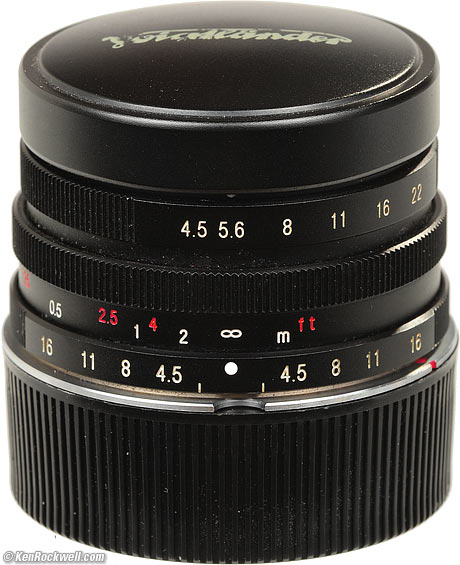
Voigtländer 15mm f/4.5 ASPH, twice life-size.
Set the guessed distance, compose through the accessory finder, and shoot.
Meter through the camera's finder. The camera's rangefinder doesn't work with this lens.
Its depth-of-field is so huge that you can set 6 feet (2 meters) and everything from 3 feet (1m) to infinity will be in focus, even at f/4.5.
I get sharp results hand-held even at 1/3 second.
Use on Nikon SLRs
You can buy an adaptor to mount this on a Nikon AI mount. The gotcha is that this 15mm lens intrudes so far into the body that you must lock up your mirror permanently.
This is no problem with pro cameras, like the Nikon F, F2, F3, F4, and F5, but doesn't happen with the F6 or digital SLRs. Many older Nikormats also have hard mirror lock-ups.
Mirrors on some DSLRs may have a "pre-release" to avoid vibration, but they let the mirror flip down after each shot. When this happens, the mirror bangs on the lens; ouch.
You probably could put foam around the back of the lens, or use duct tape to hold a DSLR mirror up all the time, but that's not my style.
Worse, there is obviously no metering with a mirror-up Nikon, and with the film cameras that have mirror lock-up, you can't just guess as you can with digital.
So now our clean options are nothing with DSLRs, and unmetered, non-TTL (separate finder) viewing with film SLRs.
It's a much better idea to use any Leica-mount camera instead, since the Voigtländer, Leica or Minolta CLE cameras add TTL metering that any of the adapted SLR conurbations won't.
The only reason I'd want to bother with an adaptor is for doing lens tests and comparisons; for actual shooting, use a Leica-mount film camera for more practical results.
Recommendations top
Intro Specs Performance Usage Recommendations
Get one; I did.
The biggest thing I don't like about this lens is trying to figure out how I'm going to justify keeping a Leica 21mm f/2.8 ASPH, or bothering to buy the Leica 18mm f/3.8 which undoubtedly will block its own viewfinder and has more distortion.
Likewise, I still need to figure out how to rig up some sort of system to use filters reliably.
Get one today before Cosina reads this and jacks the price up to $899 where it belongs, or Leica buys-out the design and charges $5,999 for it. Don't come complaining to me if you don't get one for $420 brand new today, complete with finder.
It's not just as good as, it's better optically then the Leica lenses. Since it's so much smaller than the Leica lenses, it doesn't have or need a focus tab.
You always need to order the $60 M adapter so it fits your camera. The $420 lens and finder combo is only screw mount; you need the adapter to attach permanently to the back of this lens so it fits your modern Leicas, Voigtländers and Zeiss Ikons.
If you're a Leica man who's too shy to use the best, even if it costs less, get one of these and tell your pals that you use it purely as a lens cap, and of course would never photograph through it, ever. Just be sure they don't ask you about the 15mm finder on your camera, which of course you're only using to keep dust off your precious hot shoe for when your Leica Universal Wide Finder is in your safe deposit box.
If you're not a Leica man, you can shoot this lens on any of the Zeiss Ikon, Cosina, Rollei, or Voigtländer Bessa bodies for the same results as shooting on a Leica body. The results are the same.
My favorite non-Leica body would be the Zeiss Superwide body, which is the same as the rest of these except that it lacks a finder or rangefinder, which don't work with this lens anyway. You pop the 15mm finder in the shoe, and read the Zeiss Ikon Superwide's meter off LEDs on the outside of the body.
Sure, you can buy any of the Bessas with finders and rangefinders for less than the Zeiss Superwide, but the Zeiss looks and feels so much better. If you can't appreciate beauty, stay away from photography. I've just saved you about $5,000, so live a little and spring for a Zeiss body, even if we all know it's the same as the Bessas underneath. Cosina not only makes this lens, they also make the modern Zeiss and Voigtländer bodies.
If you're even cheaper, you can use a cheaper screw-mount body, and forgo the screw-to-M adapter. Heck, for about $150, you can buy a used screw-mount, finderless Bessa-I which will work great, and includes a TTL meter.
This $420 lens and a used $150 body will give better results than a Leica M7 or M8.2 with the 21mm f/2.8 ASPH, or most likely either of the other two current superwides, any combination of which would run you about ten grand. Not a bad little lens, eh?
More Information top
Cosina's Page (in Japanese) (in English)
New version with 52mm filter thread
PLUG
I support my growing family through this website.
If I just saved you $10,000, if you find this as helpful as a book you might have had to buy or a workshop you may have had to take, feel free to help me continue helping everyone.
If you've gotten your gear through one of my links or helped otherwise, you're family. It's great people like you who allow me to keep adding to this site full-time. Thanks!
If you haven't helped yet, please do, and consider helping me with a gift of $5.00.
The biggest help is when you use any of these links when you get anything. It costs you nothing, and is this site's, and thus my family's, biggest source of support. These places always have the best prices and service, which is why I've used them since before this website existed. I recommend them all personally.
Thanks for reading!
Ken
Home New Search Gallery How-To Books Links Workshops About Contact

